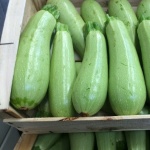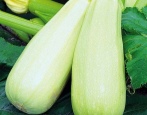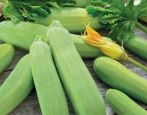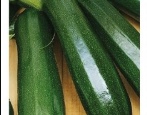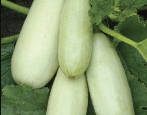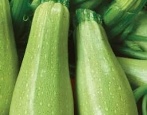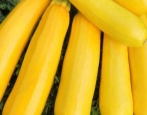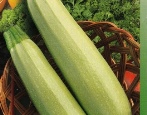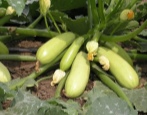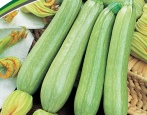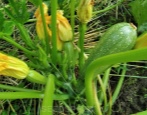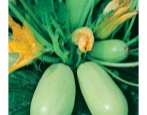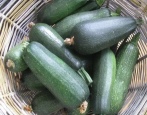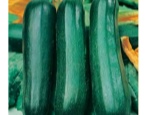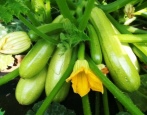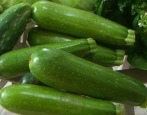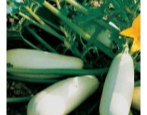
- Year of approval: 1991
- Ripening terms: early maturing
- The period from germination to harvest: 38-40 days
- Description of the plant: compact, single stem plants prevail
- Leaves: green with whitish spots, medium, medium dissection, lobes at the base of the leaf adjoining
- Fruit shape: cylindrical
- Fruit color: greenish-white, no mesh, no pattern
- Color of the pulp: white
- Pulp (consistency): medium, dense, tender, savory, slightly juicy
- Fruit weight, kg: 0,5-1,0
Zucchini Belogor is a middle-aged culture. Over the years, the variety has earned the respect of gardeners. It is often chosen for its ease of care and high-quality fruit.
Breeding history
The species in question originated in the Crimea thanks to the specialists of the plant breeding station. In 1991, zucchini became available for mass cultivation.
Description of the variety
In the characteristics of Belogor it is written that this is not an independent variety, but a hybrid. Adapted for cultivation in the open field.
Characteristics of the appearance of plants and fruits
The described plant is a neat bush in which one stem dominates. Its main shoot is short. Green leaves of moderate size are moderately dissected. At the base of the leaf, the blades approach each other.
The hybrid follows the shape of a cylinder. Each copy weighs 0.5-1 kilograms. The color of the vegetable is greenish with white fragments, there is no pattern and mesh. The bark is woody, fragile. When touched, you will notice that the surface of the squash is smooth. The white pulp is tender, fleshy, and slightly juicy in texture.
Purpose and taste
The hybrid under consideration is universal in purpose. It is used for cooking various dishes, caviar, and canning. In addition, the vegetable is introduced into the composition of some cosmetics (masks that help prolong the youthfulness of the skin, refresh it). Zucchini is often included in weight loss diets for obesity, it is advised to use it for osteochondrosis, salt deposition, gastritis, kidney disease, heart ailments, liver pathologies.
Ripening terms
Experts classify Belogor as an early maturing species. The fruiting period starts 38-40 days after planting.
Yield
The culture shows good productivity even in unfavorable climatic conditions. On average, a summer resident can count on 3.6-14.3 kilograms of zucchini per square meter.
Growing regions
The geography of Belogor cultivation is quite extensive. It can be found in the Far East, in the Central, Middle Volga, North-Western, Volgo-Vyatka regions, in the North Caucasus, in Eastern and Western Siberia.
Growing and care
Before starting to cultivate a vegetable, it is recommended to introduce manure or compost into the soil in the fall, and dig up the ground. In spring, superphosphate, humus and wood ash are added to the soil.
Sowing seeds for seedlings begins around the third decade of April. For this purpose, it is advisable to use peat glasses or containers. On the eve of sowing, the planting material is disinfected with potassium permanganate and kept in a special preparation that accelerates the simple. The seeds are immersed in the ground to a depth of 1.5-2 centimeters, moistened and wrapped in a film.
In the room, you need to try to provide warmth - 20-22 degrees.As the planting material germinates, the temperature is increased by a couple of degrees. Seedlings are formed a week after sowing.
It is customary to move young plants to a permanent growing place from May 25 to June 10. According to the parameters, the holes must correspond to the peat glasses. The plant is placed in open ground, without separating a lump of earth from the root. Adhering to the scheme, a distance of 70 centimeters is maintained between the bushes. The same gap is made between the rows. After completing the procedure, the garden bed is irrigated with warm water.
It is necessary to water Belogor systematically, as the soil dries up, for example, once a week. Irrigate more frequently during the flowering and ovary phase. After moistening, it is advised to loosen the ground and free the garden from weeds. Zucchini loves to be pampered with organic fertilizers - mullein infusion or manure. When the culture blooms, it is permissible to introduce a urea solution into the soil. When fruit ovaries appear, a complex of carbamide, phosphorus and potassium is suitable.
The harvest is removed on time, every week. To pick the fruit from the bush, use garden shears or a knife.
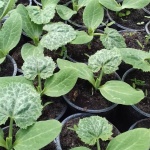
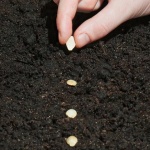
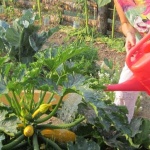
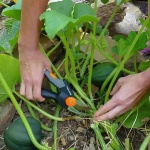
Soil requirements
The hybrid feels comfortable in loamy, clayey, light, chernozem soils.
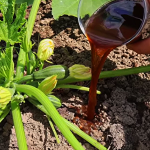
Required climatic conditions
For a normal growing season, it is recommended that the vegetable be allocated an area open to the sun.
Disease and pest resistance
This type of squash shows good resistance to gray rot, but often suffers from pathologies such as anthracnose, powdery mildew, fruit rot, and bacteriosis.
Review overview
In general, reviews of the Belogor variety are positive. They note that zucchini do not take up much space in the garden, give a bountiful harvest, are tasty and juicy.
